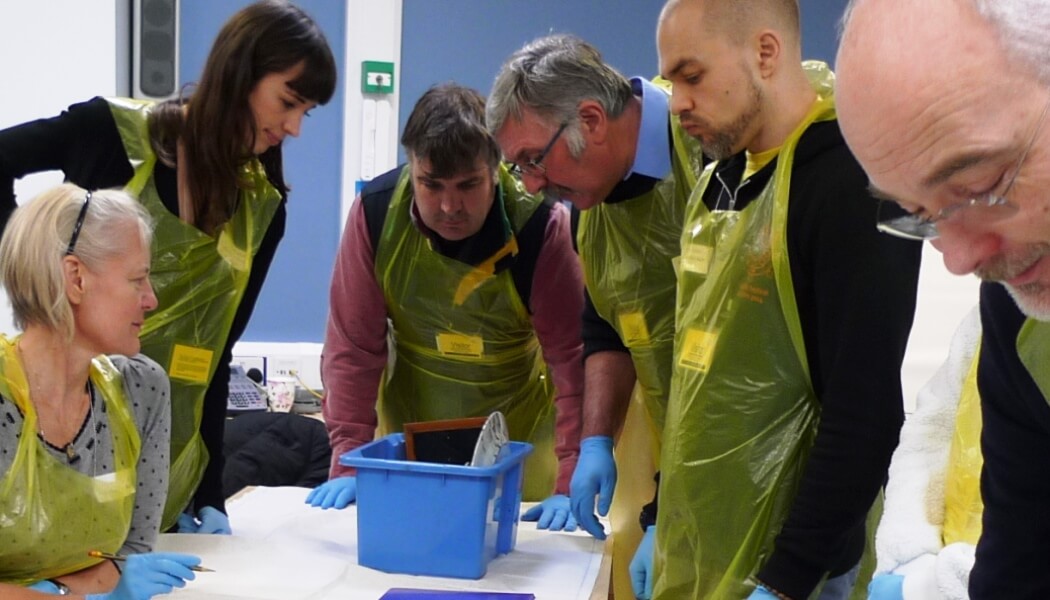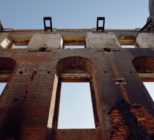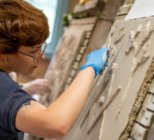What does the Emergency Planning training that you lead for SWMD involve?
We provide training on why museums need an Emergency Plan, what you would use it for and how to write it. A second session shows museums how to use their Emergency Plan (with hands-on practical sessions dealing with a simulated disaster). We also offer half-day on-site sessions to test their EP and plan ways to communicate it to all their staff (paid and volunteer). We also inform the museums about other sources of information on the internet including Collections Trust, fire and rescue services, Local Resilience Forums, and the Environment Agency flood risk register.
How many museums and cultural organisations are part of the Emergency Planning?
In the southwest we support 218 museums that are accredited or officially working towards accreditation and as much help as we can to a further 200 museums and heritage organisations.
Have you developed a universal disaster plan and if so what are some of its key points?
We have an Emergency Plan template and a suite of presentations and guidelines to help people draft and use their EP. We don’t have the resources or the remit to support a regional EP at the moment. Museums Development Officers and regional Thematic Officers (especially the Conservation Development Officer) respond when the need arises.
As a region we negotiated a county museum group membership scheme with Harwell Document Restoration Services to enable the museums to afford the subscription. Several county groups are now members of HDRS in this way, providing them with emergency triage, safe storage and access to freezers if needed. At least two museums have used HDRS this way in recent years and found it immensely helpful.

How often is the plan updated and how often do members meet up to discuss the plan?
Each museum reviews and, if necessary, updates its own plan after major changes in the museum (e.g. changes to exhibitions, building work), an incident requiring the use of the EP and at least every three years (current Accreditation requirement). We also help them assess their plan. SWMD reviews its EP template and supporting documents.
In what ways can you mitigate or prevent an emergency or disaster (insurance, security, removing risk)?
The best action any museum can take is writing a practical, workable Emergency Plan and making sure everyone in the museum is familiar with it. Just the process of gathering information and putting it together in the plan will bring to light so many points or actions that the museum needs to put right, that a considerable amount of mitigating or preventive action will have already been done before the Plan is completed.
Involve everybody in the museum in the writing of the Plan. A great deal of extra information and help may be discovered this way and everyone will be more familiar with the Plan and better able to use it. Every museum should check the cover provided by its insurance policy, including business loss while it is closed. Sign up to a disaster cover service if possible.
Good building maintenance and observation are vital. Internally, good housekeeping, and having a clear way for people to report potential problems, as well as a rapid response to any points raised are most helpful.
Thinking through what could happen enables a museum to take practical steps to mitigate the possible damage from a disaster. For example:
- Keep all objects a minimum of 10cm (4 inches) off the floor and/or house all objects near to floor level in polythene boxes, not cardboard.
- If water pipes pass through a storage area above a collection and can’t be relocated, have shielding in place to divert any possible leaks away from the objects.
- Keep a sheet of acid-free tissue spread over the contents of drawers to catch smoke deposits in the event of a fire, limiting the amount of staining and damage.
- Check gutters, drainpipes and drain covers regularly and keep them clean and repaired.
What are some of the main risks that your museums face?
In the southwest it is more common to have problems related to damp such as flooding, mould and pest infestation. Fires are rare, but there have been a few caused by lightning, electrical failures or contractors working in the building. Theft and vandalism are occasional problems, usually resulting in the loss or damage of a small part of the collection (which may be significant).
What are the simple steps that museums can take to ensure they are protected against emergencies and disasters both natural and manmade?
Write or review a practical Emergency Plan. Make sure your building is well maintained and walk round it regularly to check for possible problems. Many museums don’t own their building so they need to know who to contact when work needs to be done.
Have clear written procedures for actions in the museum, especially external contractors and follow them conscientiously.
Practice good housekeeping – empty waste every day, organise areas to avoid clutter and dispose of unwanted materials promptly.
Repair electrical items promptly and don’t overload sockets.
Keep surfaces clean – dust can build up to form a fire risk, encourages corrosion, mould and pests.
Be a good neighbour – mutual watchfulness and support can help avert disasters or enable fast and effective responses.
Remember – loss of information can be as serious as the loss of the object – make sure back-up copies of museum documentation are kept secure and up-to-date.








